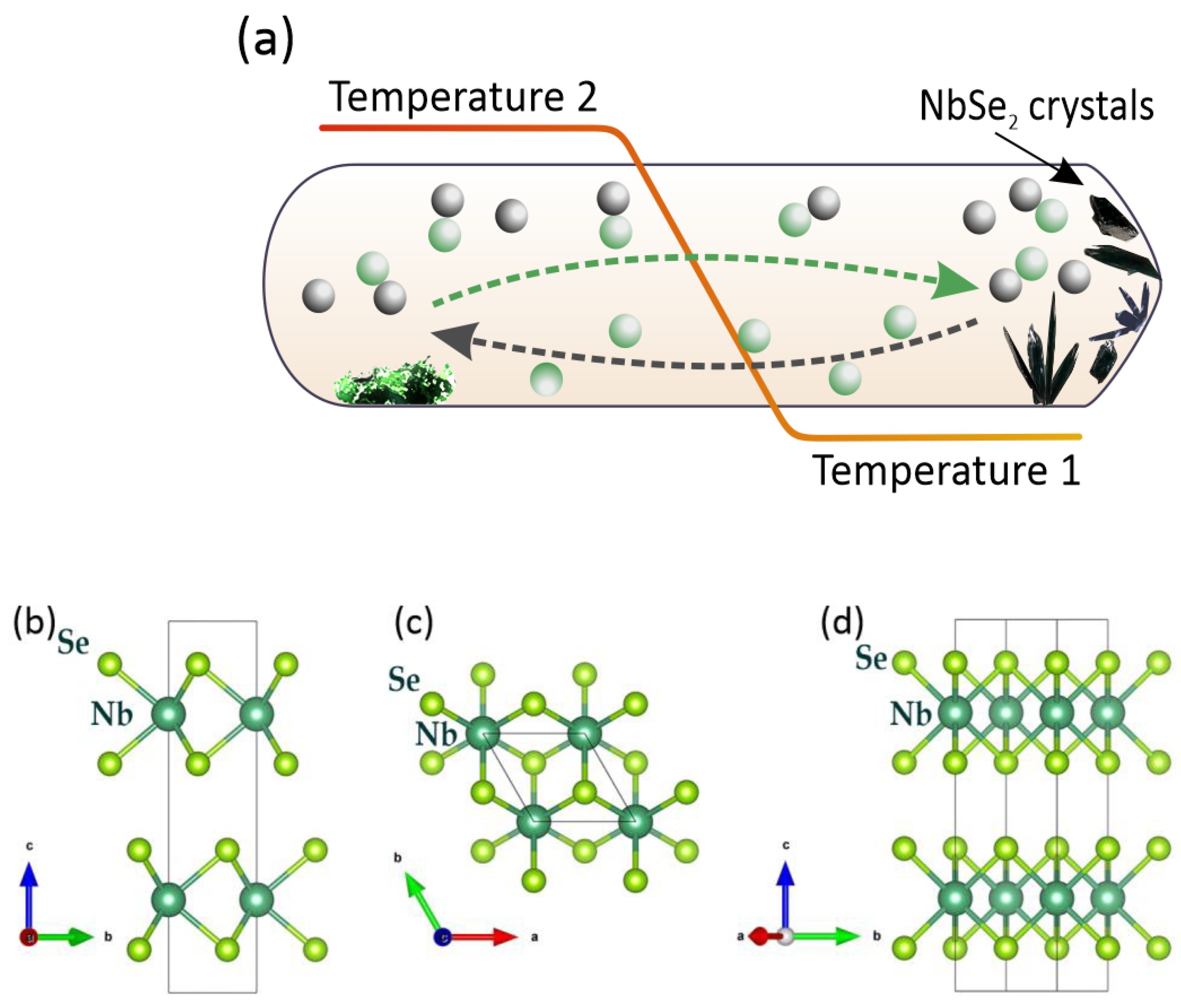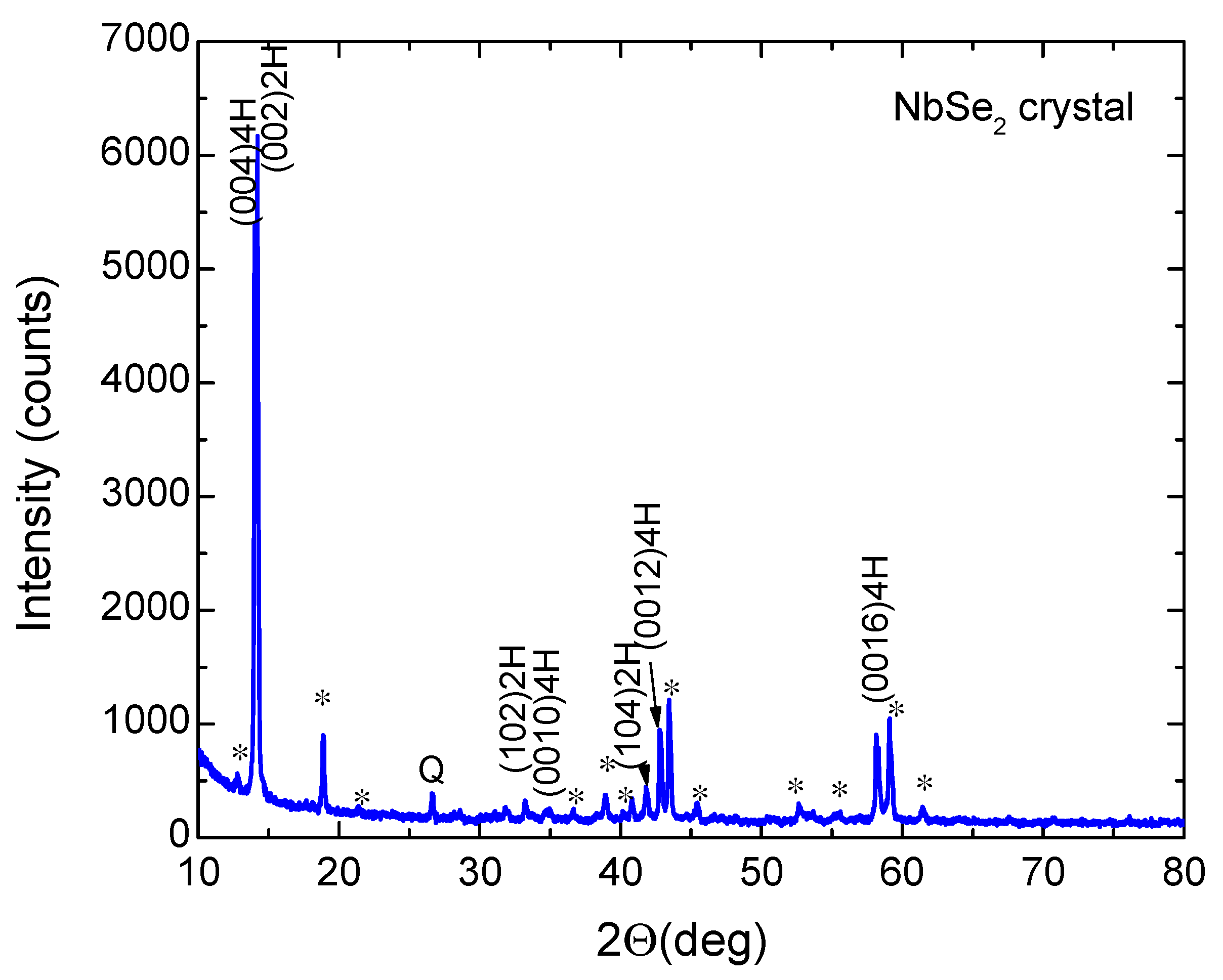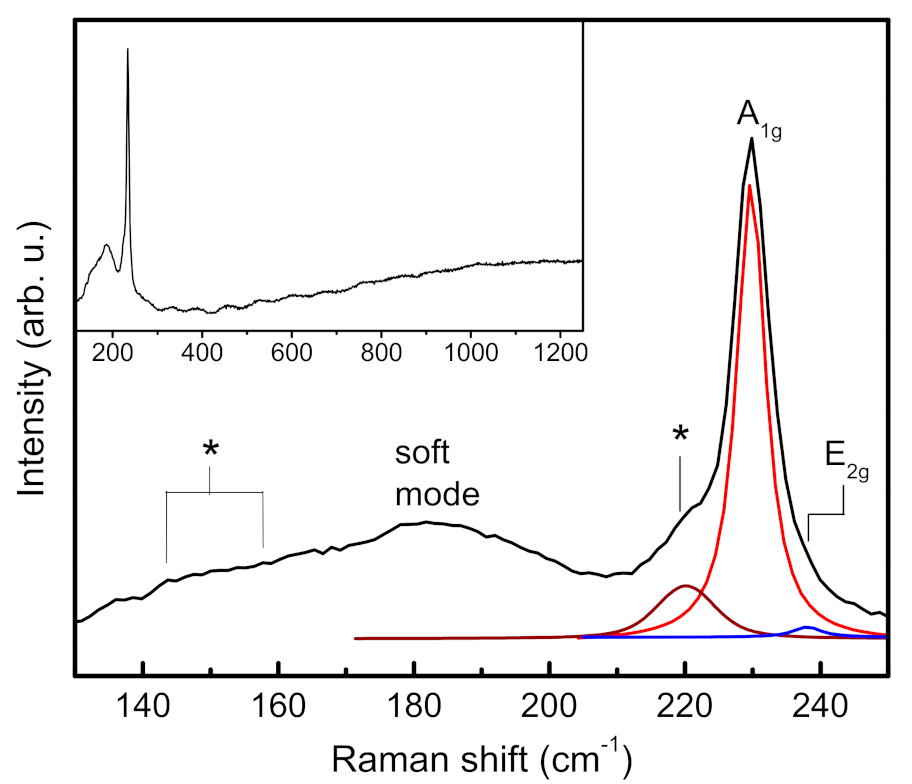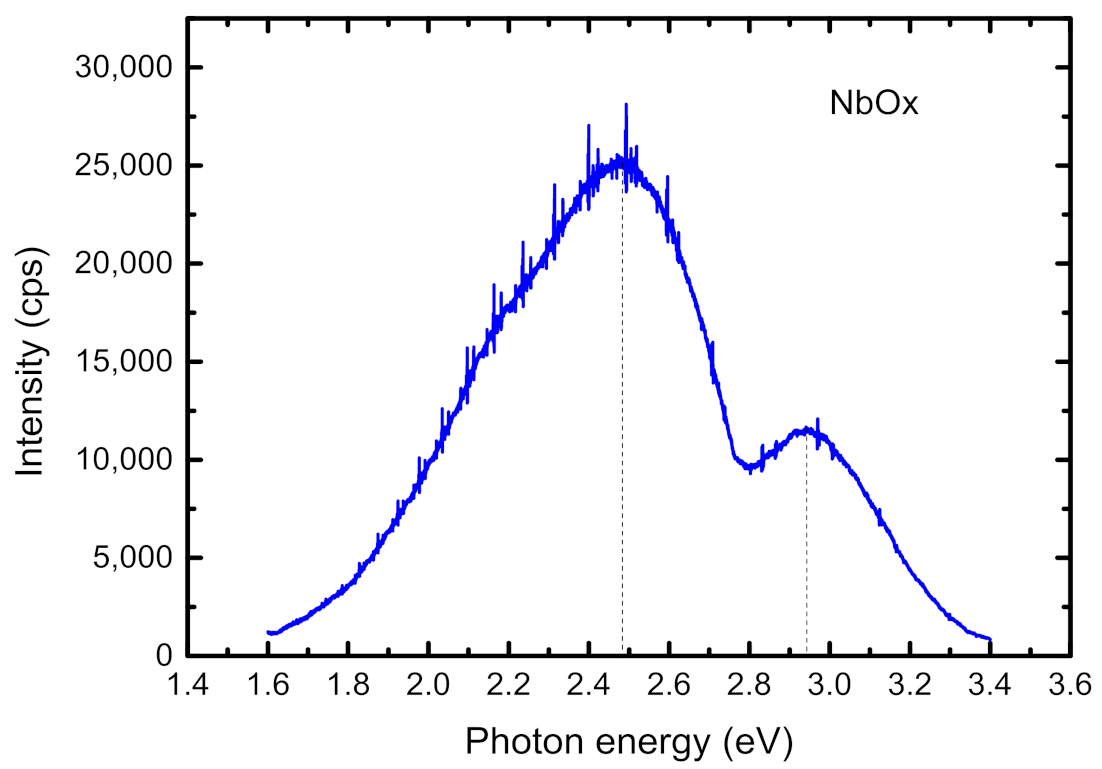NbSe2 Crystals Growth by Bromine Transport
Abstract
:1. Introduction
2. Materials and Methods
3. Results and Discussion
3.1. X-ray Diffraction Analysis (Crystalline Structure)
3.2. Raman Analysis
3.3. X-ray Photoelectron Spectroscopy (XPS)
3.4. Photoluminescence
4. Conclusions
Author Contributions
Funding
Institutional Review Board Statement
Informed Consent Statement
Data Availability Statement
Acknowledgments
Conflicts of Interest
References
- Das, S.; Robinson, J.A.; Dubey, M.; Terrones, H.; Terrones, M. Beyond Graphene: Progress in Novel Two-Dimensional Materials and van der Waals Solids. Annu. Rev. Mater. Res. 2015, 45, 1–27. [Google Scholar] [CrossRef]
- Bian, R.; Li, C.; Liu, Q.; Cao, G.; Fu, Q.; Meng, P.; Zhou, J.; Liu, F.; Liu, Z. Recent progress in the synthesis of novel two-dimensional van der Waals materials. Natl. Sci. Rev. 2022, 9, nwab164. [Google Scholar] [CrossRef] [PubMed]
- Hossain, M.; Zhao, Z.; Wen, W.; Wang, X.; Wu, J.; Xie, L. Recent Advances in Two-Dimensional Materials with Charge Density Waves: Synthesis, Characterization and Applications. Crystals 2017, 7, 298. [Google Scholar] [CrossRef]
- Tsen, A.W.; Hunt, B.; Kim, Y.D.; Yuan, Z.J.; Jia, S.; Cava, R.J.; Hone, J.; Kim, P.; Dean, C.R.; Pasupathy, A.N. Nature of the quantum metal in a two-dimensional crystalline superconductor. Nat. Phys. 2015, 12, 208. [Google Scholar] [CrossRef]
- He, W.-Y.; Zhou, B.T.; He, J.J.; Yuan, N.F.Q.; Zhang, T.; Law, K.T. Magnetic field driven nodal topological superconductivity in monolayer transition metal dichalcogenides. Commun. Phys. 2018, 1, 40. [Google Scholar] [CrossRef]
- Kim, A.R.; Kim, Y.; Nam, J.; Chung, H.-S.; Kim, D.J.; Kwon, J.-D.; Park, S.W.; Park, J.; Choi, S.Y.; Lee, B.H.; et al. Alloyed 2D Metal–Semiconductor Atomic Layer Junctions. Nano Lett. 2016, 16, 1890–1895. [Google Scholar] [CrossRef]
- Andreeva, O.; Braude, I.; Mamalui, A. Selenium vacancies and their effect on the fine structure of NbSe2 quasi-two-dimensional single crystals. Phys. Met. Metallogr. 2012, 113, 888–892. [Google Scholar] [CrossRef]
- Dasadia, A.; Bhavsar, V. Growth, structure, electrical and optical properties of transition metal chalcogenide crystals synthesized by improved chemical vapor transport technique for semiconductor technologies. Prog. Cryst. Growth Charact. Mater. 2022, 68, 100578. [Google Scholar] [CrossRef]
- Brixner, L.H. Preparation and properties of the single crystalline AB2-type selenides and tellurides of niobium, tantalum, molybdenum and tungsten. J. Inorg. Nucl. Chem. 1962, 24, 257–263. [Google Scholar] [CrossRef]
- Kershaw, R.; Vlasse, M.; Wold, A. The preparation of and electrical properties of niobium selenide and tungsten selenide. Inorg. Chem. 1967, 6, 1599–1602. [Google Scholar] [CrossRef]
- Oglesby, C.S.; Bucher, E.; Kioc, C.; Hohi, H. Growth of faceted niobium diselenide. J. Cryst. Growth 1994, 137, 289–294. [Google Scholar] [CrossRef]
- Klemm, R.A. Pristine and intercalated transition metal dichalcogenide superconductors. Phys. C Supercond. Its Appl. 2015, 514, 86–94. [Google Scholar] [CrossRef]
- Li, Z.; Xi, X.; Ding, B.; Li, H.; Liu, E.; Yao, Y.; Wang, W. Thermodynamics and kinetics synergy for controlled synthesis of 2D van der Waals single-crystal NbSe2 via modified Chemical Vapor Transport. Cryst. Growth Des. 2020, 20, 706–712. [Google Scholar] [CrossRef]
- Schmidt, M.; Gooth, J.; Binnewies, M. Preparation and crystal growth of transition metal dichalcogenides. Z. Anorg. Allg. Chem. 2020, 646, 1183–1194. [Google Scholar] [CrossRef]
- Binnewies, M.; Glaum, R.; Schmidt, M.; Schmidt, P. Chemical Vapor Transport Reactions; De Gruyter: Berlin, Germany, 2012. [Google Scholar]
- Momma, K.; Izumi, F. VESTA 3 for three-dimensional visualization of crystal, volumetric and morphology data. J. Appl. Crystallogr. 2011, 44, 1272–1276. [Google Scholar] [CrossRef]
- Chen, H.; Ma, Z.; Shao, Y.; Rehman, Z.; Zhang, K.; He, Q.; Song, L. Angle-/temperature-dependence of Raman scattering in layered NbSe3 crystal. AIP Adv. 2017, 7, 095316. [Google Scholar] [CrossRef]
- Li, H.; Liu, S.; Chen, L.; Wu, J.; Zhang, P.; Tang, H.; Li, C.; Liu, X.; Wang, Z.; Meng, J. Atomic structures and electronic properties of Ta-doped 2H-NbSe2. RSC Adv. 2014, 4, 57541–57546. [Google Scholar] [CrossRef]
- Naik, I.; Rastogi, A.K. Charge density wave and superconductivity in 2H- and 4H-NbSe2: A revisit. Pramana-J. Phys. 2011, 76, 957–963. [Google Scholar] [CrossRef]
- Hill, H.M.; Rigosi, A.F.; Krylyuk, S.; Tian, J.; Nguyen, N.V.; Davydov, A.V.; Newell, D.V.; Hight Walker, A.R. Comprehensive optical characterization of atomically thin NbSe2. Phys. Rev. B 2018, 98, 165109. [Google Scholar] [CrossRef]
- Zhang, X.; Tan, Q.-H.; Wu, J.-B.; Shi, W.; Tan, P.-H. Review on the Raman spectroscopy of different types of layered materials. Nanoscale 2016, 8, 6435–6450. [Google Scholar] [CrossRef]
- Staley, N.E.; Wu, J.; Eklund, P.; Liu, Y.; Li, L.; Xu, Z. Electric field effect on superconductivity in atomically thin flakes of NbSe2. Phys. Rev. B 2009, 80, 184505. [Google Scholar] [CrossRef]
- Xi, X.; Zhao, L.; Wang, Z.; Berger, H.; Forró, L.; Shan, J.; Mak, K.F. Strongly enhanced charge-density-wave order in monolayer NbSe2. Nat. Nanotechnol. 2015, 10, 765–769. [Google Scholar] [CrossRef] [PubMed]
- 2Dsemiconductors USA. Available online: https://www.2dsemiconductors.com/niobium-diselenide-nbse2/ (accessed on 12 April 2023).
- Calavale, F.; Dreher, P.; Surdendran, A.P.; Wan, W.; Timpel, M.; Verucchi, R.; Rogero, C.; Bauch, T.; Lombardi, F.; Casanova, F.; et al. Tailoring Superconductivity in Large-Area Single-Layer NbSe2 via Self-Assembled Molecular Adlayers. Nano Lett. 2021, 21, 136–143. [Google Scholar] [CrossRef] [PubMed]
- Ahmad, H.M.N.; Ghosh, S.; Dutta, G.; Maddaus, A.G.; Tsavalas, J.G.; Hollen, S.; Song, E. Effects of impurities on the electrochemical characterization of liquid-phase exfoliated niobium diselenide nanosheets. J. Phys. Chem. C 2019, 123, 8671–8680. [Google Scholar] [CrossRef]
- El-Bana, M.S.; Wolverson, D.; Russo, S.; Balakrishnan, G.; Paul, D.M.; Bending, S.J. Superconductivity in two dimensional NbSe2 field effect transistors. Supercond. Sci. Technol. 2013, 26, 125020. [Google Scholar] [CrossRef]
- Holler, J.; Bauried, L.; Korn, T.; Seitz, A.; Özyigit, F.; Eichinger, M.; Schüller, C.; Watanabe, K.; Taniguchi, T.; Strunk, C.; et al. Air tightness of hBN encapsulation and its impact on Raman spectroscopy of van der Waals materials. 2D Mater. 2020, 7, 015012. [Google Scholar] [CrossRef]
- Huang, B.X.; Wang, K.; Church, J.S.; Li, Y.-S. Characterization of oxides on niobium by Raman and infrared spectroscopy. Electrochim. Acta 1999, 44, 2571–2577. [Google Scholar] [CrossRef]
- Rigosi, A.F.; Hill, H.M.; Krylyuk, S.; Nguyen, N.V.; Hight Walker, A.R.; Davydov, A.V.; Newell, D.B. Dielectric Properties of NbxW1−xSe2 Alloys. J. Res. Natl. Inst. Stand. Technol. 2019, 124, 124035. [Google Scholar] [CrossRef]






Disclaimer/Publisher’s Note: The statements, opinions and data contained in all publications are solely those of the individual author(s) and contributor(s) and not of MDPI and/or the editor(s). MDPI and/or the editor(s) disclaim responsibility for any injury to people or property resulting from any ideas, methods, instructions or products referred to in the content. |
© 2023 by the authors. Licensee MDPI, Basel, Switzerland. This article is an open access article distributed under the terms and conditions of the Creative Commons Attribution (CC BY) license (https://creativecommons.org/licenses/by/4.0/).
Share and Cite
Dimitrov, D.; Rafailov, P.; Marinova, V.; Avramova, I.; Kovacheva, D.; Dionisiev, I.; Minev, N.; Gospodinov, M. NbSe2 Crystals Growth by Bromine Transport. Coatings 2023, 13, 947. https://doi.org/10.3390/coatings13050947
Dimitrov D, Rafailov P, Marinova V, Avramova I, Kovacheva D, Dionisiev I, Minev N, Gospodinov M. NbSe2 Crystals Growth by Bromine Transport. Coatings. 2023; 13(5):947. https://doi.org/10.3390/coatings13050947
Chicago/Turabian StyleDimitrov, Dimitre, Peter Rafailov, Vera Marinova, Ivalina Avramova, Daniela Kovacheva, Irnik Dionisiev, Nikolay Minev, and Marin Gospodinov. 2023. "NbSe2 Crystals Growth by Bromine Transport" Coatings 13, no. 5: 947. https://doi.org/10.3390/coatings13050947
APA StyleDimitrov, D., Rafailov, P., Marinova, V., Avramova, I., Kovacheva, D., Dionisiev, I., Minev, N., & Gospodinov, M. (2023). NbSe2 Crystals Growth by Bromine Transport. Coatings, 13(5), 947. https://doi.org/10.3390/coatings13050947







